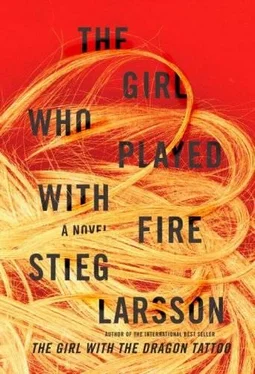“How likely do you think it is that Dag’s book was the motive for the murders?”
“Or Mia’s dissertation… I don’t know. But we can’t rule it out.”
“No, we can’t. You’ll have to keep it together.”
“Keep what together?”
“The investigation.”
“What investigation?”
“Our investigation, damn it.” Berger suddenly raised her voice. “Dag was a journalist and he was working for Millennium. If he was killed because of his job, I want to know about it. So we – as an editorial team – are going to have to dig into what happened. You’ll take care of that part, looking for a motive for the murders in all the material Dag gave us.” She turned to Eriksson. “Malin, if you help me outline a new issue today, then Christer and I will do the draft layout. But you’ve worked a lot with Dag and on other articles in the themed issue. I want you to keep an eye on developments in the murder investigation alongside Mikael.”
Eriksson nodded.
“Henry… can you work today?”
“Sure.”
“Start by calling the rest of our staff and tell them what’s going on. Then go to the police and find out what’s happening. Ask them if there’s going to be a press conference or anything. We have to stay on top of the news.”
“I’ll call everyone first. Then I’ll run home and take a shower. I’ll be back in forty-five minutes.”
“Let’s stay in touch all day.”
“Right,” Blomkvist said. “Are we finished? I have to make a call.”
Harriet Vanger was having breakfast on the glass veranda of Henrik Vanger’s house in Hedeby when her mobile rang. She answered without looking at the display.
“Good morning, Harriet,” said Blomkvist.
“Good heavens. I thought you were one of those people who never gets up before eight.”
“I don’t, as long as I have a chance to go to bed. Which I didn’t last night.”
“Has something happened?”
“You didn’t listen to the news?” Blomkvist gave her a report of the events of the night.
“That’s terrible. How are you holding up?”
“Thanks for asking. I’ve felt better. But the reason I’m calling is that you’re on Millennium’s board and should be informed. I’m guessing that some reporter will discover soon enough that I was the one who found Dag and Mia, and that will give rise to certain speculations, and when it leaks out that Dag was working on a massive exposé for Millennium , questions are going to be asked.”
“And you think I ought to be prepared. So, what should I say?”
“Tell the truth. You’ve been told what happened. You’re shocked about the murders, but you are not privy to the editorial work, so you cannot comment on any speculation. It’s the police’s job to investigate the murders, not Millennium’s. ”
“Thanks for the warning. Is there anything I can do?”
“Not right now. But if I think of something I’ll let you know.”
“Good. And Mikael… keep me informed, please.”
Maundy Thursday, March 24
The responsibility of leading the preliminary investigation into the double homicide in Enskede landed officially on Prosecutor Richard Ekström’s desk at 7:00 on the morning of Maundy Thursday. The duty prosecutor of the night before, a relatively young and inexperienced lawyer, had realized that the Enskede murders could turn into a media sensation. He called and woke up the assistant county prosecutor, who in turn woke up the assistant county chief of police. Together they decided to pass the ball to a diligent and experienced prosecutor: Richard Ekström.
Ekström was a thin, vital man five feet six inches tall, forty-two years old, with thinning blond hair and a goatee. He was always impeccably dressed and he wore shoes with slightly raised heels. He had begun his career as the assistant prosecutor in Uppsala, until he was recruited as an investigator by the Ministry of Justice, where he worked on bringing Swedish law into accord with that of the EU, and he acquitted himself so well that for a time he was appointed division chief. He attracted attention with his report on organizational deficiencies within legal security, where he made a case for increased efficiency rather than complying with the requests for increased resources demanded by certain police authorities. After four years at the Ministry of Justice, he moved to the prosecutor’s office in Stockholm, where he handled a number of cases involving high-profile robberies and violent crimes.
Within the administration he was taken for a Social Democrat, but in reality Ekström was uninterested in party politics. Even as he started to attract attention in the media, people in high places had begun to keep their eye on him. He was definitely a candidate for higher office, and thanks to his presumed party affiliation he had a broad network of contacts in political and police circles. Within the police force opinion was divided as to Ekström’s ability. His investigations had not found support among those who were advocating that the best way to promote law and order was to recruit more police. On the other hand, he had excelled at not being afraid of getting his hands dirty when he drove a case to trial.
Ekström got a briefing from the criminal duty officer about the events in Enskede, and at once concluded that this was a case which would without a doubt create a stir in the media. The two victims were a criminologist and a journalist – the latter a calling Ekström either loved or hated, depending on the situation.
He had a rapid telephone conversation with the county chief of police. At 7:15 he picked up the phone again and woke Criminal Inspector Jan Bublanski, known to his colleagues as Officer Bubble. Bublanski was off duty over Easter week due to a mountain of overtime he had accumulated during the past year, but he was asked to interrupt his time off and come to police headquarters at once to run the investigation of the Enskede killings.
Bublanski was fifty-two and had been on the force since he was twenty-three. He had spent six years in patrol cars and served in both the weapons division and the burglary division before he took additional courses and advanced to the violent crimes division of the county criminal police. By all accounts, he had taken part in thirty-three murder or manslaughter investigations in the last ten years. He had been in charge of seventeen of these investigations, of which fourteen were solved and two were considered closed, which meant that the police knew who the killer was but there was insufficient evidence to bring the individual to trial. In the one remaining case, now six years old, Bublanski and his colleagues had failed. The case concerned a well-known alcoholic and troublemaker who was stabbed to death in his home in Bergshamra. The crime scene was a nightmare of fingerprints and DNA traces left over a period of years by several dozen people who had gotten drunk or been beat up in the apartment. Bublanski and his colleagues were convinced that the killer could be found among the man’s prodigious network of fellow alcoholics and drug addicts, but despite their intensive work whoever it was had continued to elude the police.
Bublanski’s statistics were good in terms of the number of cases he had solved, and he was held in high esteem by his colleagues. But they also considered him a bit odd, partly because he was Jewish. On certain high holy days he had been seen wearing a yarmulke in the corridors of police headquarters. This had occasioned a comment from a police commissioner, soon after retired, who was of the opinion that it was inappropriate to wear a yarmulke in police headquarters, in the same way he found it inappropriate for a policeman to wear a turban on duty. There was no further discussion about the matter. A journalist heard the comment and started asking questions, at which point the commissioner quickly repaired to his office.
Читать дальше












